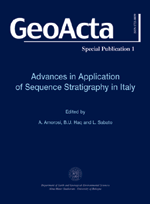GeoActa Special Publication 1
2008


Acquisto online |
GeoActa
an international Journal of Earth Sciences
|
|
Concepcion Jimenez de Cisneros, Emilia Caballero
Estacion Experimental Zaidın, CSIC, Profesor Albareda, 1, 18008 Granada, Spain. E-mail: cisneros@eez.csic.es
|
|
Concepcion Jimenez-Lopez
|
|
Dept. de Microbiologıa, Facultad de Ciencias, Universidad, 18071 Granada, Spain
|
|
|
|
d18O and d13C of modern/ancient travertines from a thermal spring (Alicun de las Torres, Southern Spain)
|
|
|
|
|
|
|
|
PDF (2.5 MB)
|
Abstract
The isotopic composition (d18O and d13C) of two travertine deposits formed from thermal spring waters in Alicun de las Torres (Granada, Southern Spain) was studied. The formation of these deposits is a consequence of the thermal shock induced by the difference between water/air temperatures that accelerates dissolved carbonate deposition, producing large travertine bodies. The first deposit is a travertine channel, in which water is flowing (active channel). The second one is situated 500 m from the spring orifice and does not display any water flow (inactive channel). The deposition of the travertine in isotopic equilibrium with the spring water was studied in the active channel deposit. This study shows that the system is not in isotopic equilibrium near the spring orifice, but tends toward isotopic equilibrium at a certain distance from the spring orifice. The calcite precipitation rate decreases as Mg2+ concentration in the spring water increases. The observations from the active channel deposit were applied to the study of a fossil travertine (inactive channel). Our study suggests that this deposition depends on the fall in water temperature, and relates in turn to the climatic thermal oscillation of the zone. Radiocarbon dating of the travertine deposit shows that deposition occurred between isotopic stages 2 and 1, at the end of the last ice age.
Keywords: stable isotopes, travertine, thermal springs, Holocene, palaeoenvironmental record
|
|
|


